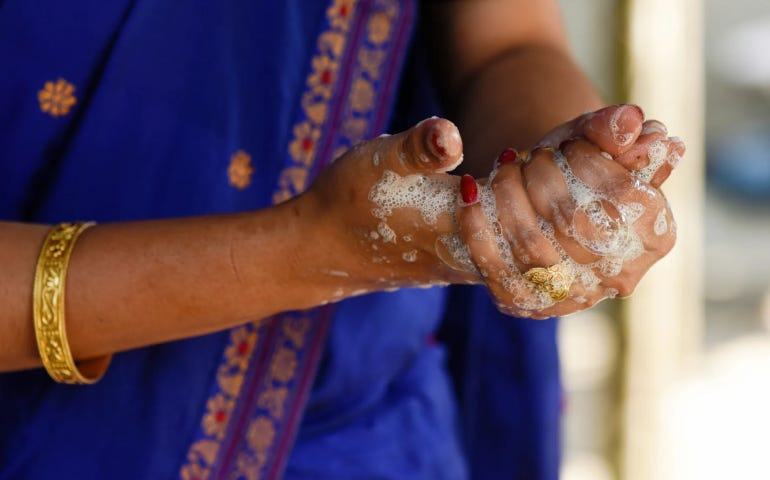Everyday Hygiene and its Impact on Health
Effective hygiene practices are the foundation of a healthier society, forming the first line of defence against preventable diseases. Yet many everyday settings, such as homes, workplaces and public transport, are places where hygiene guidelines may not always be present, making them potential hotspots for the spread of infections.1
A primary source of harmful microbes in our daily living environments is infected individuals, and these microbes can easily spread from person to person and to frequently touched surfaces.1 Diseases arising from these microbes are among the leading causes of deaths globally.2 Diarrhoea, for example, remains a leading cause of death among children aged under five years.1
The unpredictable nature of infectious diseases can lead to wide-scale health crises, including epidemics and pandemics.4 This not only bears a heavy toll on global health but also on the economy: it is estimated that a single emerging infectious disease costs the global economy $30–50 billion.5 Not only are there the direct costs of treating the disease in a medical setting and costs of loss of life but also indirect costs. These include absenteeism and lost time at work, resulting in a loss of productivity and business opportunities.

The Power of Hygiene
Globally, nearly 1.8 million young children under the age of five die each year due to pneumonia and diarrhoea alone.6 However, the simple act of handwashing with soap could be a life-saving shield, helping to protect one in every three children who suffer from diarrhoea and one in five from pneumonia.6
Hand hygiene doesn't stop at health benefits alone. By integrating hand washing education into schools and ensuring access to soap and water within educational institutions, there is a noticeable improvement in attendance.6 A healthy child has the opportunity to learn, and their regular presence in schools paves the way to a brighter future. For example, a study involving 17 rural schools in Western Kenya reported that pupil absentee rates decreased by 26% after the implementation of handwashing stations and teaching about hygiene, as well as resulting in pupil-to-parent knowledge transfer.7
Challenges in Implementing Effective Hygiene
Despite the universal importance of good hygiene, the challenges of implementing it vary across the globe. Primary issues include limited access to clean water and sanitation facilities and disparities rooted in socio-economic factors. Worldwide, 2.3 billion people lack basic hygiene services, including soap and water at home, and this includes 670 million people with no handwashing facilities at all.8
While such challenges are more noticeable in low- and middle-income countries, they also exist in high-income countries. Even within countries, disparities are evident between urban and rural regions and among disadvantaged populations.9
Research conducted by the Global Hygiene Council (GHC) revealed that cultural differences can play a significant role in hygiene education and its importance.10 For example, when primary school teachers were surveyed about whether they consider it a societal duty to teach children about handwashing, 95% of Chinese teachers agreed, compared with 64% in India.10
Steps for Change
The GHC is committed to driving worldwide behaviour change in hygiene practices to reduce the burden of common infectious diseases. In the report Making hygiene matter in the home and community setting, GHC experts outlined their recommendations and suggested steps for sustaining and encouraging effective hygiene behaviours.9
The COVID-19 pandemic underscored the importance of handwashing and surface disinfection.11 However, maintaining good hygiene habits has proven more challenging than it sounds. Since the initial COVID-19 threat has subsided, there has been a noticeable decline in hygiene practices.12
The real challenge doesn't just lie in introducing hygiene measures but in creating lifelong habits amongst the general public. In addition to investing in infrastructure, the GHC is calling upon policy makers and relevant stakeholders to put more effort into effectively communicating information about when and how to adopt new hygiene behaviours. This messaging should be easy to understand, tailored to the specific target population and should encourage a lasting shift towards sustainable hygiene habits.9
To learn more about effective hygiene practices and their role in reducing antimicrobial resistance, visit Our Work.
References:
- World Health Organization. The top 10 causes of death. Available at: www.who.int/news-room/fact-sheets/detail/the-top-10-causes-of-death (Accessed: February 2024).
- International Scientific Forum on Home Hygiene. Developing and promoting hygiene in home and everyday life to meet 21st Century needs. July 2021. Available at: www.ifh-homehygiene.org/ developing-and-promoting-hygiene-home-and-everyday-life-meet- 21st-century-needs/ (Accessed: February 2024).
- World Health Organization. The top 10 causes of death. Available at: www.who.int/news-room/fact-sheets/detail/the-top-10-causes-of-death (Accessed: October 2023)
- Centers for Disease Control and Prevention (CDC). Handwashing in communities, clean hands save lives, March 2023. Available at: www.cdc.gov/handwashing/why-handwashing.html (Accessed: February 2024).
- Blanton E, et al. Evaluation of the role of school children in the promotion of point-of-use water treatment and handwashing in schools and households-Nyanza Province, Western Kenya, 2007. Am J Trop Med Hyg. 2010;82(4):664–671.
- United Nations Universal SDGS. Access to drinking water, sanitation and hygiene. Available at: https://unstats.un.org/sdgs/report/2021/goal-06/ (Accessed: February 2024).
- Global Hygiene Council. Making Hygiene Matter in Home and Community Settings. 2023.
- Global Hygiene Council. Hygiene Behaviour Change Research Programme. 2020.
- Essack S. Water, sanitation and hygiene in national action plans for antimicrobial resistance. Bull World Health Organ. 2021;99(8):606–608.
- Bradley Corporation. Healthy Handwashing Survey. 2020. Available at: www.bradleycorp.com/handwashing (Accessed: February 2024).